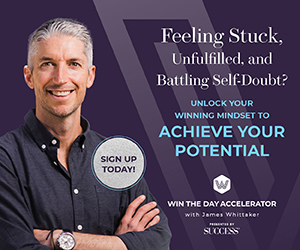For most, living in this day and age requires a level of digital immersion, inundating us with notifications and constant connectivity. While most people understand that constant digital distractions may not be great for us, the damage is hard to measure. Jim Kwik, brain coach and New York Times bestselling author of Limitless, says these digital distractions can also be a massive hindrance to our productivity and success.
“How are you supposed to get through your to-do list, much less design your life and achievements when you can’t focus?” Kwik asks. “The art of success is really the art of attention.”
Thankfully, there are ways to increase our focus and reduce digital distractions. According to Kwik, focus isn’t binary, where we either have it or we don’t. Learning how to deal with digital distractions is really more about training and strengthening that muscle over time.
How to reduce digital distractions: Understand the power of focus
Kwik believes the ability to focus is not a passive quality but an active choice.
“Focus isn’t something you have; it’s something you do,” Kwik says. “When you take nouns and turn them into verbs, it allows you to have agency as opposed to just hoping. Hope is not a great strategy.”
When controlling our awareness and where our attention is going, Kwik explains that the brain’s reticular activating system (RAS) controls a great deal. Also known as the extrathalamic control modulatory system, this part of the brain filters through the deluge of information we receive every day to determine what’s important and what should be muted.
One way he suggests tapping the RAS when dealing with digital distractions is by asking new questions.
“When you get lost and you’re frustrated, ask yourself, ‘Hey, what’s the best use of this moment?’ Or ‘What’s the most important thing that I could focus on?’ It just helps you to get that spotlight on things that you can control,” Kwik says.
Brain coach Jim Kwik’s morning routine advice
“What a lot of people do first thing in the morning is they’ll flex their distraction muscles by picking up their device,” Kwik says. “And when you wake up in the morning and you’re in this relaxed state of awareness, you’re just very suggestible. When the first thing you do is grab for your phone, you’re rewiring your brain for two things that are hurting your productivity or performance.”
The first of those two things is that the brain strengthens the habit of reacting early in the morning. With social media, texts and emails, it’s easy for our brains to suddenly switch into defense mode to fight fires.
“You probably have woken up and gotten a social media message, voicemail message, email [or] text, and it just puts you in a mood for hours, and we lose our focus,” Kwik says.
The second thing Kwik says happens when you grab your phone is a flex of your distraction muscles. We get better at what we practice more, and Kwik says that particular distraction exercise early in the morning can come into play later in the day in meetings or when we need to focus.
Instead of reaching for your phone in the morning, if you’re learning how to reduce digital distractions, Kwik suggests utilizing a thought experiment instead.
“I begin with the end in mind,” Kwik says, explaining that he typically visualizes going back to bed at the end of the day thinking about why that day was great, breaking it down into three personal and three professional things. This way, he has six attainable goals to focus on for the rest of the day.
Try the F.O.C.U.S. method to reduce digital distractions
In addition to the thought experiment exercise, brain coach Jim Kwik developed a practical acronym, F.O.C.U.S., as a guide for dealing with digital distractions effectively.
F: Free Time Scheduling
Allocate specific times for breaks and leisure activities.
“Most people don’t schedule white space, and your brain’s not meant to go full blast all day,” Kwik says. “You need to take little brain breaks, to rejuvenate yourself, to recover, especially for people who struggle with peaks and valleys of their energy.”
O: Organized
Keep your digital workspaces clean and organized to reduce mental clutter.
“Your external world is a reflection of your internal world,” Kwik explains, suggesting a spring cleaning of digital spaces such as your desktop and files. “Keep your digital workspaces clean and organized so you don’t also have to mentally think about where everything is, because it uses a lot of energy and focus. If you have all these tabs open, even if they’re minimized, they’re using resources.”
C: Consciousness
Be mindful of your digital usage and consciously monitor your online activities.
“Most people don’t even look at their summary reports, like how much usage they have, how much time they’re spending on Instagram or social media or email,” Kwik says. Because engaging in social media creates a dopamine flood, and dopamine is a motivation molecule, Kwik says it becomes addictive. “Technology is a tool for us to use. But if the technology is using us, then we become the tool, right? And that’s really not the goal.”
U: Unplug
Schedule regular digital detoxes to reset and recharge.
“I think the most important function on your phone is airplane mode,” Kwik says, recommending regularly scheduled chunks of time when the phone is off or on airplane mode. “I’m not saying any of this is easy. But if you want the benefit that comes from resetting and recharging, getting off those devices is important.”
S: Set Boundaries
Define specific times for checking emails and social media to avoid constant interruptions.
“Time chunk things in a way that doesn’t have to burn a lot of brain glucose,” Kwik says. “If you’re doing a specific activity, part of your brain’s cognitive web is lit up. But if you switch from that to doing something else… then you have to shut this down, turn another on, and then use a lot of brain glucose that gives you energy.”
The result of switching tasks and expending so much brain glucose? A feeling of exhaustion or depletion. Multitasking is also ineffective for our focus.
“If you’re checking emails and then you’re multitasking, maybe writing a proposal and going back and forth, it could take five to 10 minutes to regain your focus, so you actually lose time,” Kwik explains.
In a world where information overload and digital distractions are the norm, mastering your focus can create a significant advantage. By implementing Jim Kwik’s Limitless strategies, individuals can build a foundation for success, productivity and a more fulfilling life in the digital age.
This article originally appeared in the March issue of SUCCESS+ digital magazine. Photo by fizkes/Shutterstock.com




